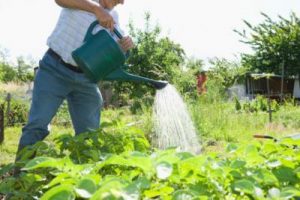Best watering methods for gardens during hot-weather gardening
University of Illinois Extension — July 28, 2020Every day matters when extremely high temperatures beat down on flowers, vegetables, and lawns. University of Illinois Extension Horticulture Educator Richard Hentschel reminds gardeners that consistent and faithful watering is vital to maintaining the health of summer plants.
Tips for containers and planters
- Container soils are designed to drain well so containers and planters need to be checked daily. Large plantings should be checked twice a day.
- Never let plants wilt, as they come back at the expense of future flowers.
- If overly dry, the container mix will shrink and pull away from the sides. Water the container a second time to ensure complete water absorption.
- Deadhead regularly so energy goes to more flower production.
Tips for lawns
- Water regularly to keep the lawn green and benefiting from any fertilization, or allow the lawn to go naturally dormant and reduce mowing.
- Even when naturally dormant, a one-half inch of water every two weeks is needed to keep the grass plant crowns alive until fall.
- Wait for the lawn to return to active growth before applying any weed control products.
- Southern and western exposures will require more frequent watering. Consider more drought-tolerant grasses on these hotter, drier exposures.
Tips for newly planted trees, shrubs, and evergreens
- New plantings will have a limited root system, limiting water availability.
- When watering, be sure to water the location with the root ball.
- A two- or three-inch layer of mulch extending past the planting hole will conserve moisture, moderate extremes in soil temperatures, and act as a weed barrier. Use proper mulching technique.
- Trees, shrubs and evergreens are woody and will not show drought conditions until it is too late, so monitor closely.
- Do not fertilize the first season since this forces growth the root system cannot support.
- If the trees, shrubs or evergreens have a watering berm, watering will be much quicker.
Tips for vegetables
- Any vegetable that produces a fruit will need adequate water from the time the fruit set occurs through harvest.
- Bulb crops, such as onions, will stop expanding without a constant, even supply of moisture.
- Without consistent watering, tomatoes will have blossom end rot or the tomato skin will split.
- Harvest early in the morning after the plants have been able to catch up overnight on water from a hot day.
- Season-long vegetables also benefit from an organic mulch just like trees, shrubs, and evergreens.
- To prevent or slow vegetable disease, water the soil, not the plant.
In general, watering should occur in the morning to allow time for leaves to dry before nightfall.








